Useful Examples of Journal Entries: Free Journal Entry Sample Form for Download
What Is a Journal Entry?
Journal entries are created when a transaction occurs and posted into a general ledger.
When journal entries are made, they consist of both a debit and a credit and they must equal one another. Compound journal entries may consist of one debit and two or more credits and vice versa, however, they must still equal after the entry is made. Finally, you may find you need to make an adjusting journal entry or AJE.
Journal entries usually consist of the date, a description of the entry, account names, and columns for the debits and credits.
Journal Entry Examples
In order to help you understand how journal entries work, first download and print the Journal Entry Sample found in our Media Gallery. Now that you have that in front of you, let’s take a look at some sample journal entries.
Say your business purchases some needed office supplies for $200. When making a journal entry, keep in mind that debits and credits must be equal. Here’s what your journal entry would look like:
Journal Headings: Date / Description / Amount / Account / Debit / Credit
- 3/5 – Purchase office supplies – $200 - 363 – Debit Office Supply Expense
- 3/5 – Check 1001 Acme Office Supplies - $200 – 101 – Credit Cash In Bank
What if while you’re purchasing office supplies for $200 you decide to buy a fax machine for $1,500; total spent $1,700. This would require a compound journal entry:
Journal Headings: Date / Description / Amount / Account / Debit / Credit
- 3/5 – Check 1001 Acme Office Supplies - $1700 – 101 – Credit Cash In Bank
- 3/5 – Purchase office supplies - $200 – 363 – Debit Office Supply Expense
- 3/5 – Purchase fax machine - $1,500 – 161 – Debit Office Equipment Asset Acct.
Or, what if instead of paying immediately for your office supplies and fax machine, you charge it and have 30 days to pay the office supply store. Your journal entry would look like this:
Journal Headings: Date / Description / Amount / Account / Debit / Credit
- 3/5 – Purchase office supplies - $200 – 363 – Debit Office Supply Expense
- 3/5 – Purchase fax machine - $1,500 – 161 – Debit Office Equipment Asset Acct.
- 3/5 – Accounts Payable - $1,700 – 201 – Credit Accounts Payable
Finally, when you do pay the office supply store for the supplies and fax machine, your journal entry would appear as:
Journal Headings: Date / Description / Amount / Account / Debit / Credit
- 3/5 – Check 1001 Acme Office Supply - $1,700 – 101 – Credit Cash in Bank
- 3/5 – Accounts Payable - $1,700 – 201 – Debit Accounts Payable to Clear Debt
The key to successful journal entries is making sure your debits equal your credits and that transactions are posted to the correct accounts.
Adjusting Journal Entries
Beyond the typical example of journal entries, there are also adjusting journal entries or AJEs. If we stick to our office store example, what if you had to return the fax machine and were only refunded $1,200 for the fax machine and were charged a $300 restocking fee? Here’s how you would make the journal entry:
Journal Headings: Date / Description / Amount / Account / Debit / Credit
- 3/5 – Return Fax Machine - $1,200 – 161 – Credit Office Equipment Asset Acct.
- 3/5 – Refund Check for Fax - $1,200 – 101 – Debit Cash in Bank
- 3/5 – Return Fax Machine Fee - $300 – 161 – Credit Office Equipment Asset Acct.
- 3/5 – Restocking Fee Charged - $300 – 364 – Debit Misc. Fee Expense Acct.
Here, to keep accurate books, you must account for the restocking fee because the first part of this journal entry will only take $1,200 out of your office equipment asset account. To handle this you must credit that account and debit the appropriate expense for the transaction to be a true AJE in order for your books to balance and ensure debits and credits are equal.
Summing Up JEs and AJEs

The world of financial accounting may seem confusing to some but also offers enjoyment to those who understand why they are needed to ensure accurate record keeping. Why not utilize the Sample Journal Entry form in our Media Gallery and practice some examples of journal entries using scenarios and your chart of accounts.
This post is part of the series: All About Journal Entries
Find tips and advice on how to record journal entries for all types of transactions along with free, downloadable forms you can use for a variety of accounting purposes.
